by Lisa Cooke | Jul 8, 2015 | 01 What's New, Church, Irish, Libraries, Records & databases
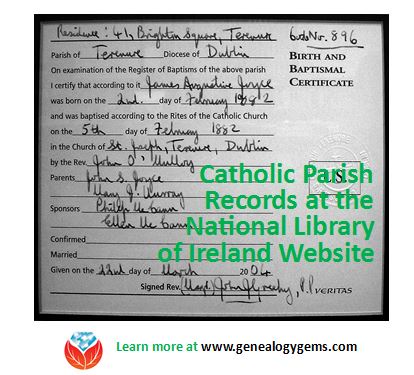
Writer James Joyce’s baptismal certificate; click to link to Wikipedia image.
As of today, the National Library of Ireland expects to launch a free, digitized collection of ALL its Catholic parish registers on its website (this link takes you to the English version; it’s also available in Irish). Nearly 400,000 digital images of microfilmed parish records comprise this collection.
According to a press release, “The parish register records are considered the single most important source of information on Irish family history prior to the 1901 Census. Dating from the 1740s to the 1880s, they cover 1,091 parishes throughout the island of Ireland, and consist primarily of baptismal and marriage records….Their digitisation means that, for the first time, anyone who likes will be able to access these registers without having to travel to Dublin.”
Catholic parish registers are a vital genealogical resource. In addition to the names of those baptized or married, they usually include those event dates, names of parents of baptized children, godparents and witnesses (who may also be relatives).
NOTE: This is a browsable-only collection. There are currently no plans to index or transcribe the records. However, the press release included a great suggestion for accessing indexes: look to local family history centers for that parish or neighborhood. “The buy diet medication online nationwide network of local family history centres holds indexes and transcripts of parish registers for their local areas,” it says.
 Those unfamiliar with Ireland research may assume this means local FamilySearch Family History Centers, but a map shows only a few of these in Ireland. I would start first with the network of county genealogy centers, accessible online at Roots Ireland. According to that site, “The county genealogy centres are based in local communities, working with volunteers, local historical societies, local clergy, local authorities, county libraries and government agencies to build a database of genealogical records for their county. By using this website you are supporting that work and the communities from which your ancestors originated.” Several counties actually already have online records you can access through the Roots Ireland link above. Ancestry also has several databases of Irish Catholic parish registers.
Those unfamiliar with Ireland research may assume this means local FamilySearch Family History Centers, but a map shows only a few of these in Ireland. I would start first with the network of county genealogy centers, accessible online at Roots Ireland. According to that site, “The county genealogy centres are based in local communities, working with volunteers, local historical societies, local clergy, local authorities, county libraries and government agencies to build a database of genealogical records for their county. By using this website you are supporting that work and the communities from which your ancestors originated.” Several counties actually already have online records you can access through the Roots Ireland link above. Ancestry also has several databases of Irish Catholic parish registers.
For more tips on researching your Irish relatives, listen to the FREE Family History Made Easy podcast episode 21, in which we interviewed Irish expert Judith Wight. You’ll hear her tips on finding Church of Ireland records, civil registrations, estate records and how history helps us understand gaps in the records.
Thank you for sharing this post with those who will LOVE to know about these Irish genealogy resources!
by Lisa Cooke | Jan 14, 2014 | 01 What's New, Conferences
I’m pleased to return this year to speak at the 45th Annual Southern California Genealogy Jamboree. This popular conference, hosted by The Southern California Genealogical Society, runs June 6 to 8, 2014 in Burbank, California, USA.
The theme of the 2014 Jamboree is Golden Memories: Discovering Your Family History. It promises to pack tons of fun into a long weekend, as it always  does. According to the press release, “Our heritage focus will be on European ancestors. Class sessions are scheduled for German, Irish, English/UK, Scotland, Eastern Europe, Italian, Mennonite, Swedish, and Russian, as well as African American and Jewish classes. Jamboree will be the culmination of a year-long celebration of the Society’s 50th Anniversary, and special activities will commemorate the Decade of the 60s. Dust off your tie dye tees and pillbox hats and take part in our Sunday noon ‘fashion show.’ Winner by popular vote will receive a free registration to the 2015 Jamboree.”
does. According to the press release, “Our heritage focus will be on European ancestors. Class sessions are scheduled for German, Irish, English/UK, Scotland, Eastern Europe, Italian, Mennonite, Swedish, and Russian, as well as African American and Jewish classes. Jamboree will be the culmination of a year-long celebration of the Society’s 50th Anniversary, and special activities will commemorate the Decade of the 60s. Dust off your tie dye tees and pillbox hats and take part in our Sunday noon ‘fashion show.’ Winner by popular vote will receive a free registration to the 2015 Jamboree.”
My classes on Friday and Saturday include:
- “Who Needs Google Reader? Flip Out Over Genealogy Content with Flipboard!” Learn how to use the free Flipboard app to turn your favorite genealogy web content into your own free customized digital magazine. You will flip over how fun and easy they are to create and share. Perfect for genealogists and societies!
- “Ultimate Google Search Strategies for Genealogists.” Learn Google search techniques, tricks and tips to achieve better genealogical search results, and then elevate your search to a strategic level. Finally, see how all of this applies across the spectrum of free Google Tools.
- “How to Create an Exciting Interactive Family History Tour with Google Earth.” Learn to tell your ancestor’s story in a captivating multi-media way in Google Earth. Incorporate images, videos, genealogical documents, and historic maps and bring it all together in a virtual family history tour for sharing and research analysis.
SCGS Jamboree 2014 welcomes 55 speakers, over 60 exhibitors, 134 class sessions for a variety of experience levels, and special events. Online registration is open on the Jamboree website, and the Marriott’s website is ready to take your reservation. Hope to see you there!
by Lisa Cooke | Nov 27, 2013 | 01 What's New, History, Newspaper
We just celebrated the 150th anniversary of President Abraham Lincoln’s now famous speech at the dedication of the Gettysburg Cemetery, a national
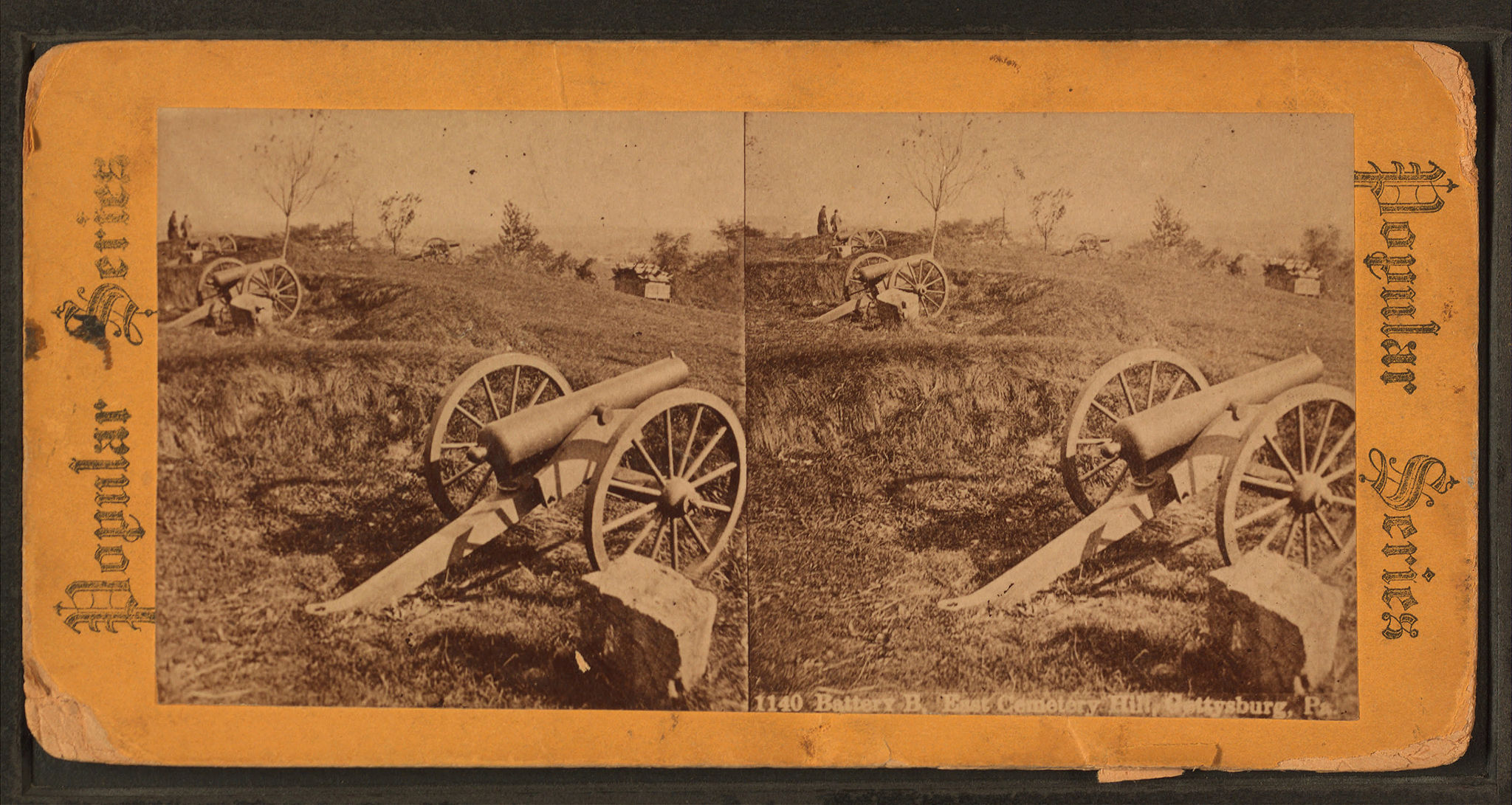
Battery B, East Cemetery Hill, Gettysburg, Pa, from Robert N. Dennis collection of stereoscopic views. Wikimedia Commons Image.
cemetery created at the site of one of the bloodiest battles of the Civil War.
Presidents give a lot of speeches–and most are never remembered. But the Gettysburg Address, as it came to be known, was immediately appreciated as something special. The press described it as “a perfect gem…unexpected in its verbal perfection and beauty.”
150 years ago today The Caledonian newspaper reprinted the entire speech. (Don’t stop there: you can read high-resolution digital versions of all five of Lincoln’s handwritten copies of the address and learn all kinds of things about the Address at the Google Cultural Institute.
The Gettysburg Address is part of the genealogy of every American whose ancestors lived through the Civil War. Few were unaffected by the War, whether they lived in the North, South or further West. Certainly its tensions and outcomes shaped the nation’s economy, social mores and more for decades to come.
Life-shaping battles and other events–and responses to them like the Gettysburg Address–appear in newspapers. That’s why I love teaching genealogists about using newspapers, and why I wrote the book How to Find Your Family History in Newspapers. The “daily news” of the past tells us what people were doing and saying and why.
 If you’re wondering what the Google Cultural Institute (GCI) is, you’re not alone. It’s a less-heralded but really important part of what Google offers. The GCI is a Google effort launched in 2011 to “make important cultural material available and accessible to everyone and to digitally preserve it to educate and inspire future generations.” (From GCI FAQ.) As of mid-2013, over 6 million photos, videos and documents are on the site, including all kinds of international cultural materials. If you haven’t explored the many Google tools helpful to genealogists, I suggest you read my book The Genealogist’s Google Toolbox. Either of these books will make a great holiday gift to yourself–and your research!
If you’re wondering what the Google Cultural Institute (GCI) is, you’re not alone. It’s a less-heralded but really important part of what Google offers. The GCI is a Google effort launched in 2011 to “make important cultural material available and accessible to everyone and to digitally preserve it to educate and inspire future generations.” (From GCI FAQ.) As of mid-2013, over 6 million photos, videos and documents are on the site, including all kinds of international cultural materials. If you haven’t explored the many Google tools helpful to genealogists, I suggest you read my book The Genealogist’s Google Toolbox. Either of these books will make a great holiday gift to yourself–and your research!
by Lisa Cooke | Sep 4, 2013 | 01 What's New, Ancestry, Technology
Like anyone else who sells a popular product, Ancestry.com is always tweaking little things to improve the user’s experience. They’ve been working on some updates, some of which you may have noticed on the site over the summer and some of which are rolling out gradually over the next couple of weeks:
1. A simple search form with the check-box option to match all terms exactly.
2. Search results shown grouped by category. This is great–no more scrolling through lots of results when you’re looking for specific kinds of records. This sort feature also reminds us to check categories we may be overlooking, like city directories and local histories. These first two-features are opt-in: learn how to do it here and see what it looks like below:
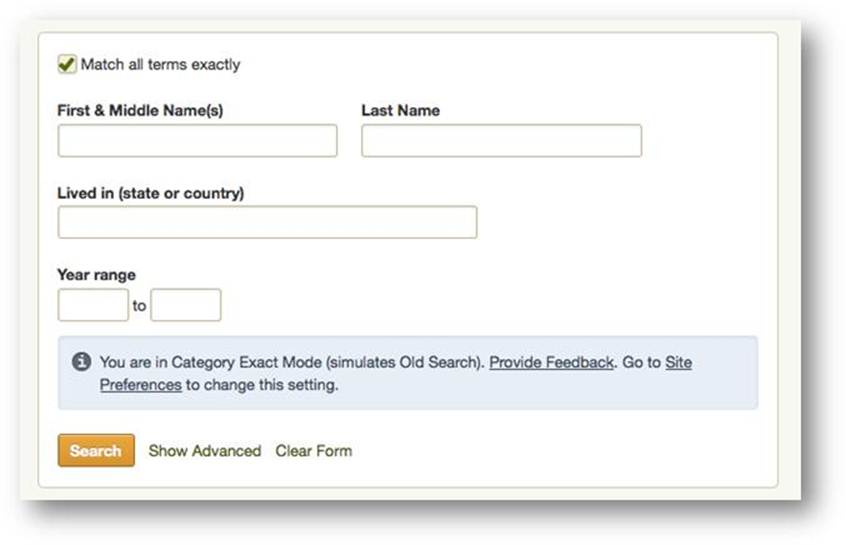 3. A summary box at the top of search results showing what you’ve already attached to your ancestor. The list is sorted alpha-numerically so you can see easily which records have been found and where there might be gaps (see what it looks like below). You can collapse this list if you want to give you more room to see the search results.
3. A summary box at the top of search results showing what you’ve already attached to your ancestor. The list is sorted alpha-numerically so you can see easily which records have been found and where there might be gaps (see what it looks like below). You can collapse this list if you want to give you more room to see the search results.
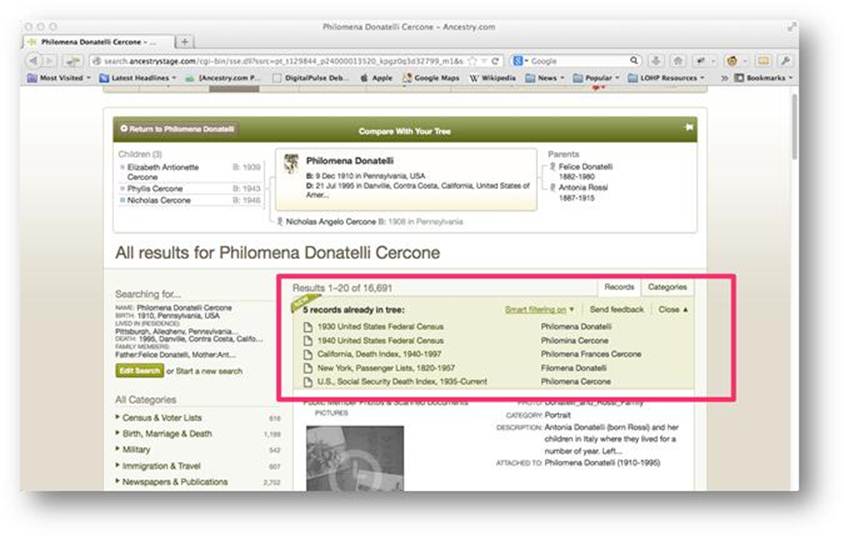
4. A filter that removes search results similar to types you already found for that ancestor. For example, if you already have a death record for someone, the filter will remove other death records. “Smart filtering” is an optional feature, so you can still choose to see the full list. Read more about it here and see it here:
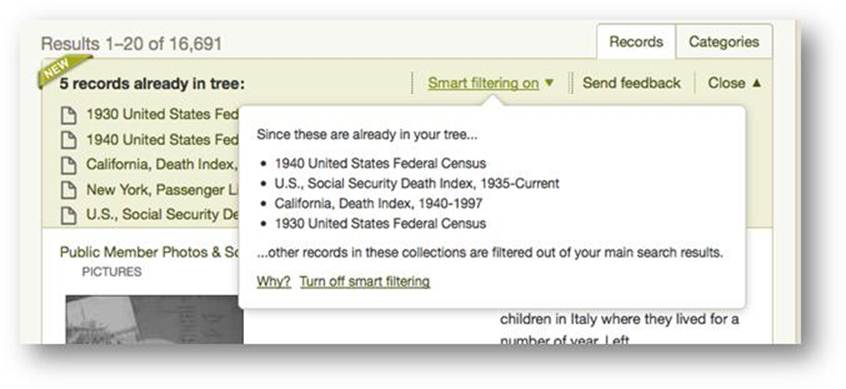 Ancestry says they will provide plenty of feedback opportunities for these new features. Don’t be shy: tell them what you like (and what you don’t) and why!
Ancestry says they will provide plenty of feedback opportunities for these new features. Don’t be shy: tell them what you like (and what you don’t) and why!
 Those unfamiliar with Ireland research may assume this means local FamilySearch Family History Centers, but a map shows only a few of these in Ireland. I would start first with the network of county genealogy centers, accessible online at Roots Ireland. According to that site, “The county genealogy centres are based in local communities, working with volunteers, local historical societies, local clergy, local authorities, county libraries and government agencies to build a database of genealogical records for their county. By using this website you are supporting that work and the communities from which your ancestors originated.” Several counties actually already have online records you can access through the Roots Ireland link above. Ancestry also has several databases of Irish Catholic parish registers.
Those unfamiliar with Ireland research may assume this means local FamilySearch Family History Centers, but a map shows only a few of these in Ireland. I would start first with the network of county genealogy centers, accessible online at Roots Ireland. According to that site, “The county genealogy centres are based in local communities, working with volunteers, local historical societies, local clergy, local authorities, county libraries and government agencies to build a database of genealogical records for their county. By using this website you are supporting that work and the communities from which your ancestors originated.” Several counties actually already have online records you can access through the Roots Ireland link above. Ancestry also has several databases of Irish Catholic parish registers.

 does. According to the press release, “Our heritage focus will be on European ancestors. Class sessions are scheduled for German, Irish, English/UK, Scotland, Eastern Europe, Italian, Mennonite, Swedish, and Russian, as well as African American and Jewish classes. Jamboree will be the culmination of a year-long celebration of the Society’s 50th Anniversary, and special activities will commemorate the Decade of the 60s. Dust off your tie dye tees and pillbox hats and take part in our Sunday noon ‘fashion show.’ Winner by popular vote will receive a free registration to the 2015 Jamboree.”
does. According to the press release, “Our heritage focus will be on European ancestors. Class sessions are scheduled for German, Irish, English/UK, Scotland, Eastern Europe, Italian, Mennonite, Swedish, and Russian, as well as African American and Jewish classes. Jamboree will be the culmination of a year-long celebration of the Society’s 50th Anniversary, and special activities will commemorate the Decade of the 60s. Dust off your tie dye tees and pillbox hats and take part in our Sunday noon ‘fashion show.’ Winner by popular vote will receive a free registration to the 2015 Jamboree.”
 If you’re wondering what the Google Cultural Institute (GCI) is, you’re not alone. It’s a less-heralded but really important part of what Google offers. The GCI is a Google effort launched in 2011 to “make important cultural material available and accessible to everyone and to digitally preserve it to educate and inspire future generations.” (From GCI
If you’re wondering what the Google Cultural Institute (GCI) is, you’re not alone. It’s a less-heralded but really important part of what Google offers. The GCI is a Google effort launched in 2011 to “make important cultural material available and accessible to everyone and to digitally preserve it to educate and inspire future generations.” (From GCI 

